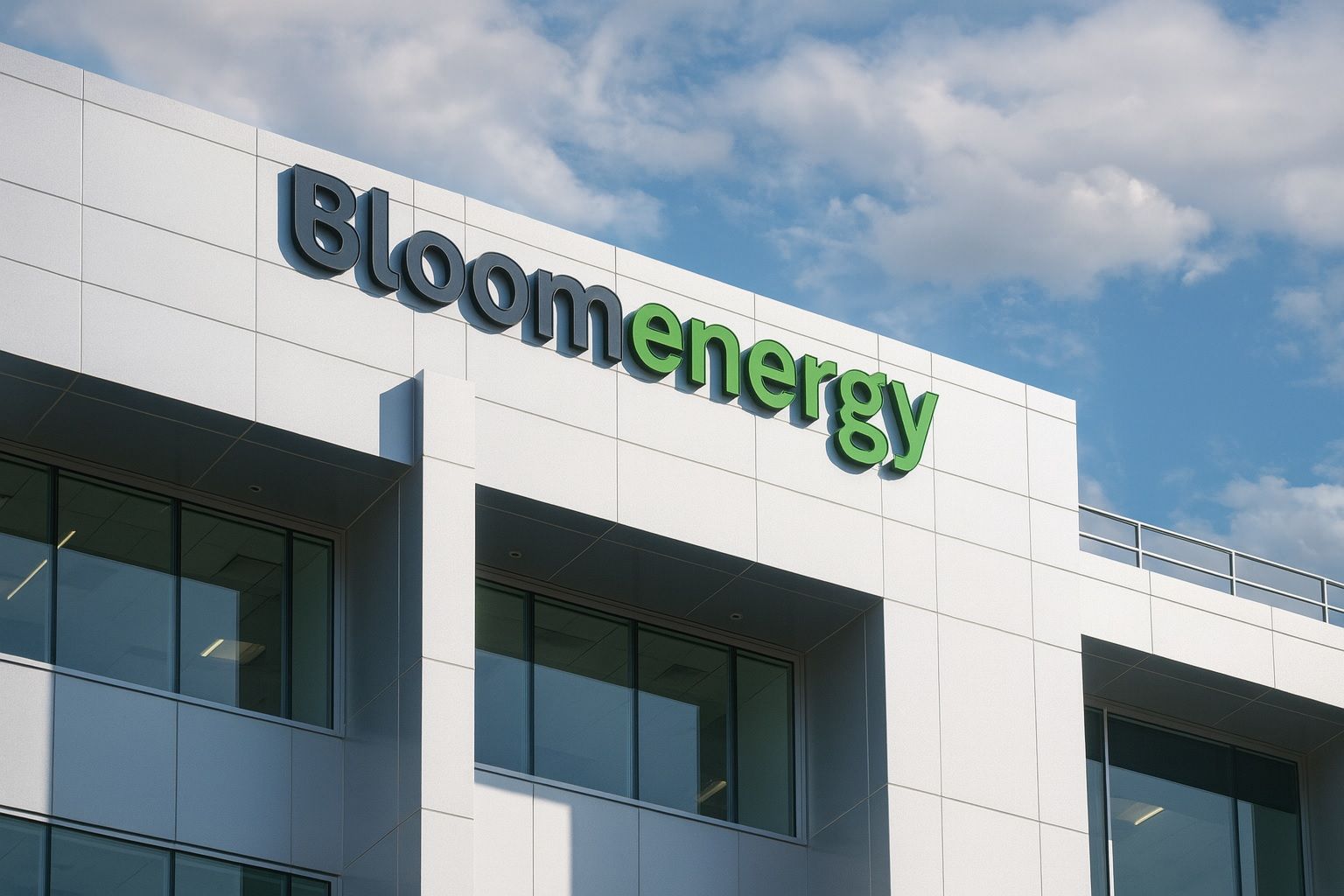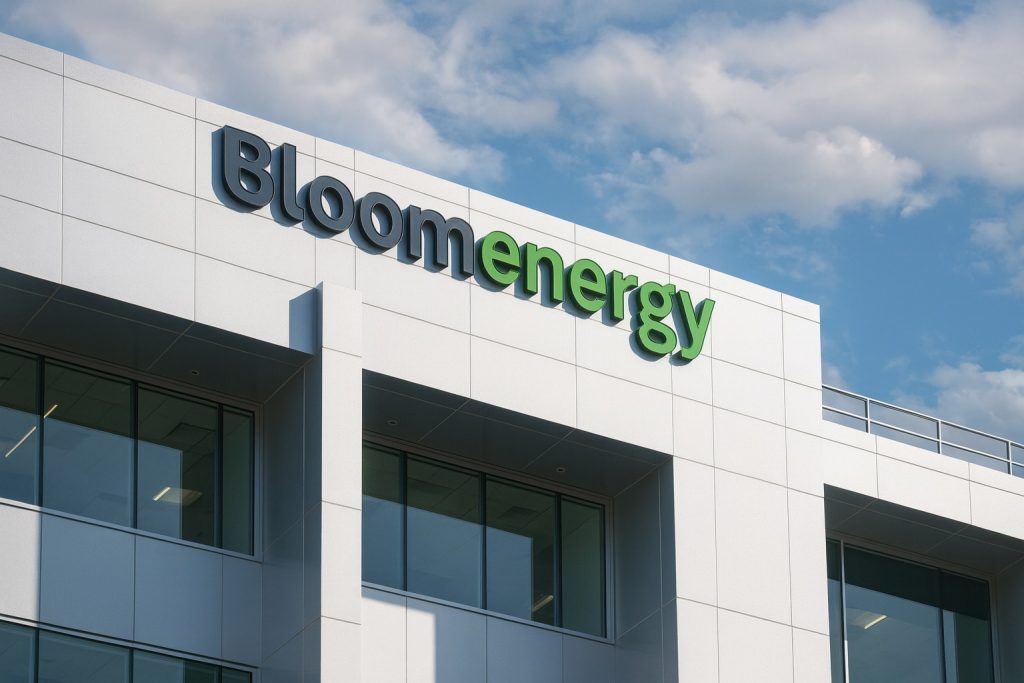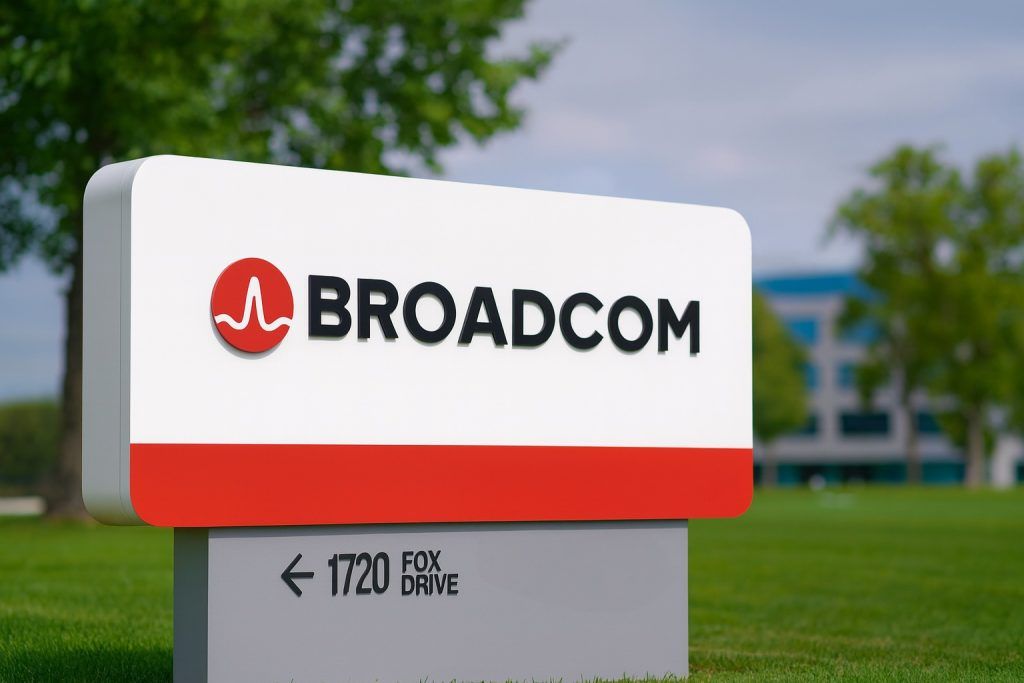- Stock price (Oct 13, 2025): ~$110 (pre-market) [1] [2], up ~26–30% on the day. 52-week range $9.02–$95.70; market cap ≈ $20.3 billion [3]. Year-to-date, BE has jumped nearly 700% on the AI/clean-energy narrative [4] [5].
- Trading volume: Spiked sharply on Oct 13 (far above its 30-day average ~14M shares [6]) as news broke.
- Latest news: Oct 13 – Brookfield Asset Management announced a up-to-$5 billion partnership to deploy Bloom’s fuel cells in AI data centers [7], sending the stock up ~30% pre-market [8]. Other recent headlines include Morgan Stanley’s Oracle AI data-center deal and multiple analyst upgrades.
- Recent earnings (Q2 2025): Revenue $401.2 M (up 19.5% YoY) [9], gross margin 26.7% (vs 20.4% prior year) [10], and operating loss narrowed to $3.5 M [11]. Non-GAAP operating profit was $28.6 M, marking six consecutive profitable services quarters. The company beat EPS and revenue estimates [12].
- Guidance: Reaffirmed FY2025 revenue guide of $1.65–$1.85 billion [13] (consensus ~$1.8B) with ~29% non-GAAP gross margin; analysts see ~19% sales growth in 2025 [14] [15].
- Key deals: Major data-center partnerships: Oracle (AI data centers) [16] [17], Equinix (deploying Bloom cells at 19 sites, ~100 MW) [18], and American Electric Power (up to 1 GW SOFCs for AI centers) [19]. Most recently, Brookfield’s $5B AI infrastructure deal [20] was a game-changer.
- Analysts: Susquehanna raised its BE price target to $105 (positive rating) on Oct 13 [21]. UBS also boosted its target to $105 (Buy) [22]. Morgan Stanley (Overweight, $85 PT) and Wells Fargo ($65) cited AI demand [23], while BMO/RBC set $75 and HSBC $100 targets [24] [25]. Consensus remains mixed (some Holds), but Wall Street tone has turned bullish.
- Sector context: Fuel-cell and hydrogen names are in vogue. In early Oct, Plug Power spiked ~170% on a bullish upgrade and higher power prices [26], and Ballard Power jumped 23% on the “halo effect” [27]. This clean-energy hype has lifted peers, albeit some analysts caution both Plug and Bloom remain unprofitable [28] [29].
Stock Performance & Trading Activity
Bloom Energy stock has surged dramatically in 2025. After closing at $86.87 on Oct 10 (its pre-news level), BE jumped roughly 26–31% on Oct 13 premarket following the Brookfield announcement [30] [31]. By mid-morning, the stock was trading around the low-$110s. This rally comes atop an astonishing one-year gain: BE is up about 700% over the past 12 months [32] [33]. Daily trading volume has spiked, far exceeding its ~14 million share average [34], reflecting frenzied interest.
Over the last few weeks, BE has repeatedly hit new 52-week highs. The stock briefly traded near $95 in late Sept before consolidating, then broke out again on the Brookfield news. Intraday volatility is high – e.g. on Oct 10 (pre-announcement) the range was $85.11–$92.73 [35] – but the recent volume surge shows buyers aggressively stepping in. At ~$20.3B market cap [36], BE is now by far the largest US fuel-cell company. Its valuation is astronomical (trailing P/S ~12x [37]), reflecting sky-high growth expectations.
Breaking News & Recent Announcements
On Oct 13, 2025, Bloom Energy unveiled a landmark deal with Brookfield Asset Management: Brookfield will invest up to $5 billion to deploy Bloom’s solid-oxide fuel cells in new “AI factories” (data centers optimized for AI) worldwide [38]. This first-of-its-kind AI infrastructure partnership is Brookfield’s inaugural move under its dedicated AI strategy. Management said the two firms will co-design global AI data centers, with a European site to be announced by year-end [39] [40]. This news sent BE stock soaring – Reuters reported a 31% jump to $113.72 premarket [41], and other sources cited ~26–30% gains [42].
Bloom’s CEO KR Sridhar hailed the partnership: “AI factories demand massive power, rapid deployment, and real-time load responsiveness that legacy grids cannot support… [We are] reimagining the data center of the future” [43]. The deal builds on earlier AI-related wins: in late July Bloom announced a direct agreement with Oracle to power Oracle AI data centers [44] [45]. Other recent announcements include expanding its work with Equinix (fuel cells at many colocation centers) and with American Electric Power (up to 1 GW off-grid for data centers) [46]. These contracts underscore Bloom’s niche: fast, on-site power for hyperscale users.
Apart from deals, Bloom’s earnings reports have made headlines. On July 31, 2025, Bloom reported Q2 2025 results (period ended June 30): revenue $401.2M (+19.5% YoY) [47] and non-GAAP gross margin 28.2% [48]. It reiterated full-year guidance of $1.65–1.85B revenue [49]. Comments from management emphasized record quarterly financials and the AI opportunity. The Bloomberg Price monitoring service (Nasdaq) headlined “Bloom Energy Booms on AI Power Demand and Analyst Upgrades” after these results.
Analyst & Expert Commentary
Analysts have turned largely bullish on BE in recent months. Susquehanna (Oct 13) maintained a Positive rating and lifted its 12-month target to $105 (from $43) [50]. UBS (Sep 19) also raised its target to $105 [51], citing Bloom’s “time to power advantage” and data-center demand. Other upgrades include Morgan Stanley (Overweight, PT $85) and Wells Fargo ($65) after Oracle AI bookings exceeded estimates [52]. BMO Capital and RBC independently set targets near $75 [53], while HSBC (recently Hold) even boosted its target to $100 [54]. MarketBeat data show two analysts rating BE as Strong Buy, eight as Buy, though the consensus remains a Hold (average target ~$54) [55].
Expert commentary notes Bloom’s unique positioning: its fuel cells can be deployed in months, unlike traditional power plants which take years. UBS pointed out this “speed-to-market” is a game-changer for data centers [56]. Hedge funds and AI specialists have touted Bloom as a key beneficiary of the AI boom. On social media (Stocktwits), BE was trending despite some bearish chatter [57].
However, many caution that Bloom is still unprofitable on a GAAP basis. Motley Fool analyst Reuben Brewer wrote that investors “need to consider what [the 700%] means on the valuation front… There’s just one problem: The company has a long history of being unprofitable” [58]. Zacks Research similarly warns that despite the hype, BE has steep costs and operating losses (FY2025 EPS still expected negative) and trades at lofty multiples. In the fuel-cell space, Zacks noted BE’s 2025 sales consensus (~$1.8B, +19%) outpace Plug Power’s (~$715M, +14%) [59], but both need to deliver on growth to justify their multiples.
Financial Performance & Earnings Insights
Bloom’s latest financials show rapid growth and improving profitability (on a non-GAAP basis). In Q2 2025, total revenue hit $401.2 M [60], with product+service revenue $351.1 M (+25.9% YoY) [61]. Gross margin widened to 26.7% [62] (non-GAAP 28.2%), up over 6 points year-over-year. While GAAP operating loss was $3.5 M [63], this was a big improvement from a $23.1 M loss a year earlier. On a non-GAAP basis, Bloom achieved $28.6 M operating income, reflecting lower costs (see table [64]). The result was a slight GAAP net loss per share (-$0.18) but a positive non-GAAP EPS of $0.10 [65], beating Wall Street forecasts.
Management highlighted this quarter as “the latest in a string of record financial quarters” [66]. Both CEO Sridhar and the acting CFO noted robust AI-driven demand. Importantly, Bloom reiterated 2025 guidance: $1.65–$1.85 B in revenue, ~29% non-GAAP gross margin, and $135–$165 M non-GAAP operating income [67]. This guidance implies continued year-over-year growth (consensus expected ~+19%). Market analysts expect Bloom to remain modestly unprofitable (GAAP) through 2025, with break-even on GAAP EPS perhaps in sight for 2026 if growth and margins hold.
Bloom’s balance sheet also strengthened: the company’s gross margin expansion (up to 26–28% in 2025 vs ~20% in 2024) and reduced losses suggest improving unit economics. It achieved six straight quarters of profitable services margins [68], and the cash burn has moderated. Still, debt is notable – long-term debt/equity ~227% [69] – so execution is critical.
Business Fundamentals & Strategic Moves
Bloom’s core technology is solid-oxide fuel cells (SOFCs), which generate on-site power by converting fuels (natural gas, hydrogen, biogas) without combustion. The company has shipped ~1.5 GW of capacity to date [70] (deployments in 1,200+ sites globally). Its Energy Server units (pictured) can be linked modularly to scale from kilowatts to tens of megawatts [71] [72]. Bloom’s products are fuel-agnostic – they can run on natural gas now (to meet demand) and can transition to cleaner hydrogen or biogas when available [73].
A key fundamental driver is speed-to-power: Bloom cells can go from order to full deployment in months [74] [75], far faster than the 3–5+ year lead times for new gas turbines or solar farms. This has attracted data-center operators (who can’t wait years for grid upgrades). The company’s service contracts provide recurring revenue (backlog ~$9B as of start-2025 [76]), and its product backlog was ~$2.5B [77] – all fueling a multi-year growth runway. Bloom is now investing to double its manufacturing capacity from 1 GW to 2 GW per year by end-2026 [78], requiring ~$100M in CapEx.
Recent strategic moves: besides Brookfield, Bloom inked a first-ever direct fuel-cell supply deal with Oracle in July 2025 [79], allowing Oracle to install Bloom power in selected AI data centers within 90 days. It also expanded an existing Equinix partnership (fuel cells at 19 sites) [80] [81]. In energy markets, it deepened a collaboration with South Korea’s SK ecoplant, tapping lucrative hydrogen incentives abroad [82]. Meanwhile Bloom is developing hydrogen electrolysis and carbon-capture products (in early stages).
However, some challenges remain. Critics note that today most Bloom servers still run on natural gas (because green hydrogen supply is scarce) [83]. In fact, a planned Bloom deal with Amazon (3 data centers in Oregon) was canceled due to hydrogen economics [84]. This underscores that Bloom’s ultimate “clean” promise depends on broader hydrogen infrastructure, not guaranteed. Still, Bloom claims its SOFCs can use biogas or clean hydrogen and has pointed to US tax credits (IRA Section 48E) that could offset fuel costs in the future. The company competes indirectly with battery storage, diesel backup, and (in the long run) small modular reactors – but currently, fuel cells offer a unique niche for instant on-site power in a smaller footprint.
Market & Competitor Comparison
Bloom Energy sits in the clean-tech power market alongside hydrogen and fuel-cell names. Key peers include Plug Power (PEM electrolyzers/fuel cells), Ballard Power (fuel cells for vehicles), and FuelCell Energy (utility-scale fuel cells). A recent TS2 analysis notes Plug and Bloom appeal to similar investors betting on clean power and AI demand [85]. However, fundamental models differ: Bloom’s solid-oxide cells target heavy power users (data centers, utilities), whereas Plug focuses on hydrogen production and fuel-cell trucks/forks.
Sector sentiment has been enmeshed in the hydrogen hype. As TS2 reports, an H.C. Wainwright upgrade on Plug (Oct 2025) sent Plug stock +170%, pulling Ballard up 23% on a “halo effect” [86] [87]. Bloom’s rally is part of this wave. But experts caution that, like Plug, Bloom has historically burned cash. Motley Fool warns that Bloom’s P/S ratio (~12x) is unprecedented [88]. By contrast, a company like NextEra (utility/renewables) trades at ~5x. So while Bloom’s growth story is compelling, it faces stiff competition from any firm offering low-carbon power – including turbine-makers and emerging battery/storage vendors.
Overall, Bloom is often compared to how Tesla disrupted auto: it sells a radically different technology (SOFC) for power generation. Analysts point to its “fuel flexibility” and nearly 100 MW/acre power density [89] as advantages. The company argues its cost of electricity is already comparable to gas turbines (with higher efficiency and lower emissions) [90]. If hydrogen becomes cheap, Bloom could effectively leapfrog gas turbines. On the other hand, if the hydrogen economy stalls, or if a competitor (like GE or Wärtsilä) develops faster fuel-cell tech, Bloom could see headwinds.
Risks, Challenges & Investor Sentiment
Investor sentiment is currently exuberant but wary. The stock’s ~700% YTD rise suggests a lot is priced in. Many retail and institutional investors are optimistic about AI/data center demand (Brookfield deal) and policy tailwinds (IRA clean-energy credits). Social media sentiment on platforms like Stocktwits was mixed – still trending strongly bullish even when fundamentals were cautious [91].
Key risks include Bloom’s history of losses – it has never reported a GAAP profit. As Motley Fool notes, this makes P/E meaningless [92]. Analysts also point out execution risk: Bloom must execute rapid factory expansions and complex global projects simultaneously. Any delays (e.g. supply chain, permitting) could strain resources. Future competition is another risk: as AI data centers proliferate, companies may also consider nuclear, grid upgrades, or new battery solutions.
Regulatory factors are double-edged. U.S. tax credits for hydrogen and fuel cells (under the Inflation Reduction Act) could subsidize Bloom projects, but policy changes (e.g. speed of IRA rollout) could affect economics. The cancellation of Bloom’s Amazon deal highlights that if customers demand 100% green fuel, Bloom’s reliance on natural gas is a vulnerability [93]. Bloom has noted these challenges in SEC filings: for example, securing hydrogen supply and winning bids in foreign markets (like South Korea) are listed as critical uncertainties [94] [95].
Despite these caveats, many analysts remain bullish on BE’s story. Susquehanna’s recent report explicitly sees “strong price appreciation” potential [96]. The Street’s upgrades and heavy media coverage (e.g. TS2, Nasdaq, Bloomberg) reflect a broad consensus: Bloom is a high-risk, high-reward stock riding the AI/energy megatrend.
Medium- to Long-Term Outlook
Over the coming months and years, Bloom’s trajectory will hinge on data-center demand for reliable green power and on execution of its growth plans. In the near term, analysts expect BE to maintain rapid sales growth (~20%+ in 2025 and 2026) as backlog converts to revenue [97] [98]. If Bloom meets or beats its guidance, plus shows early benefits of the Brookfield deal, that could sustain momentum.
Longer term, Bloom aims to scale into a major energy infrastructure player. Its 2025 Data Center Power Report suggests massive market size (on-site generation adoption projected to surge [99]). If Bloom can double capacity as planned, it could potentially deliver multiple GW of fuel-cell power by 2030. The Brookfield partnership itself may open new capital and projects, giving Bloom a path to 10–20 GW of installations in the AI era (some analysts cite a $9B backlog from Brookfield alone).
However, some experts warn that perfection will be required to justify the stock’s lofty valuation [100]. Even if AI demand is real, unforeseen hurdles (economic downturn, tech setbacks, competition) could slow growth. Thus, while bullish forecasts abound, prudent investors will watch for concrete execution milestones: the actual deployment of the Brookfield AI factories, ramping of the new factory capacity, and early profitability trends.
In summary, as of Oct 13, 2025 Bloom Energy sits at a crossroads of opportunity and risk. Its fuel-cell technology and recent AI-focused partnerships position it at the heart of a booming trend [101] [102]. The stock’s extreme rally reflects that. Yet, the company still needs to prove that its billion-dollar contracts translate into lasting profitability. The next few quarters (and any Q3 results) will test whether Bloom’s hype can blossom into sustained growth or if investors are banking on too much too soon.
Sources: Official filings and press releases [103] [104]; Reuters news [105] [106]; TS2.tech market reports [107] [108]; Bloomberg/MarketBeat summaries [109] [110]; DatacenterDynamics and industry coverage [111] [112]; financial analysis from Nasdaq/Zacks [113] [114]; and others cited above.
References
1. ts2.tech, 2. www.reuters.com, 3. www.google.com, 4. ts2.tech, 5. www.nasdaq.com, 6. www.google.com, 7. www.reuters.com, 8. www.reuters.com, 9. investor.bloomenergy.com, 10. investor.bloomenergy.com, 11. investor.bloomenergy.com, 12. www.marketbeat.com, 13. investor.bloomenergy.com, 14. www.nasdaq.com, 15. investor.bloomenergy.com, 16. investor.bloomenergy.com, 17. www.datacenterdynamics.com, 18. www.datacenterdynamics.com, 19. www.datacenterdynamics.com, 20. www.reuters.com, 21. www.marketbeat.com, 22. www.investing.com, 23. www.investing.com, 24. www.investing.com, 25. www.marketbeat.com, 26. ts2.tech, 27. ts2.tech, 28. www.nasdaq.com, 29. ts2.tech, 30. ts2.tech, 31. www.reuters.com, 32. ts2.tech, 33. www.nasdaq.com, 34. www.google.com, 35. www.google.com, 36. www.google.com, 37. www.nasdaq.com, 38. www.reuters.com, 39. www.reuters.com, 40. www.datacenterdynamics.com, 41. www.reuters.com, 42. ts2.tech, 43. www.datacenterdynamics.com, 44. investor.bloomenergy.com, 45. www.datacenterdynamics.com, 46. www.datacenterdynamics.com, 47. investor.bloomenergy.com, 48. investor.bloomenergy.com, 49. investor.bloomenergy.com, 50. www.marketbeat.com, 51. www.investing.com, 52. www.investing.com, 53. www.investing.com, 54. www.marketbeat.com, 55. www.marketbeat.com, 56. www.investing.com, 57. stocktwits.com, 58. www.nasdaq.com, 59. www.nasdaq.com, 60. investor.bloomenergy.com, 61. investor.bloomenergy.com, 62. investor.bloomenergy.com, 63. investor.bloomenergy.com, 64. investor.bloomenergy.com, 65. www.marketbeat.com, 66. investor.bloomenergy.com, 67. investor.bloomenergy.com, 68. investor.bloomenergy.com, 69. www.reuters.com, 70. investor.bloomenergy.com, 71. www.coresite.com, 72. www.coresite.com, 73. www.datacenterdynamics.com, 74. www.datacenterdynamics.com, 75. www.coresite.com, 76. ts2.tech, 77. www.nasdaq.com, 78. www.datacenterdynamics.com, 79. www.datacenterdynamics.com, 80. www.datacenterdynamics.com, 81. www.nasdaq.com, 82. www.nasdaq.com, 83. www.datacenterdynamics.com, 84. www.datacenterdynamics.com, 85. www.nasdaq.com, 86. ts2.tech, 87. ts2.tech, 88. www.nasdaq.com, 89. www.nasdaq.com, 90. www.datacenterdynamics.com, 91. stocktwits.com, 92. www.nasdaq.com, 93. www.datacenterdynamics.com, 94. investor.bloomenergy.com, 95. investor.bloomenergy.com, 96. www.marketbeat.com, 97. investor.bloomenergy.com, 98. www.nasdaq.com, 99. www.coresite.com, 100. www.nasdaq.com, 101. www.reuters.com, 102. www.datacenterdynamics.com, 103. investor.bloomenergy.com, 104. investor.bloomenergy.com, 105. www.reuters.com, 106. www.reuters.com, 107. ts2.tech, 108. ts2.tech, 109. www.marketbeat.com, 110. www.marketbeat.com, 111. www.datacenterdynamics.com, 112. www.datacenterdynamics.com, 113. www.nasdaq.com, 114. www.nasdaq.com







